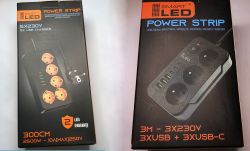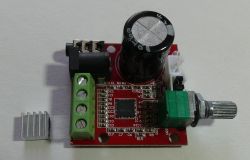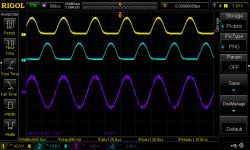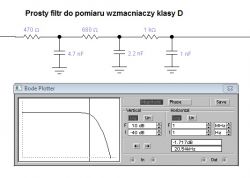The amplifier module with PAM8610 has a power connector, terminals for connecting speakers, a minijack input and a volume control potentiometer. The kit includes a small heat sink to stick to the PAM8610 chip. Class D declared by the seller suggests energy efficiency, while the possibility of working at 12V may allow for power supply from a gel battery. Module to be found in online stores by searching for the phrase: PAM8610 .
The material is a continuation of the previous one with a similar amplifier module based on PAM8403 : https://www.elektroda.pl/rtvforum/topic3458041.html
When testing the PAM8403, it turned out that the circuit at the output generates "chaff", while the current consumption is increased when we connect the 8om resistor at the output instead of the loudspeaker (with measurable inductance).
After connecting the module with the PAM8610, it turned out that without the presence of an input signal in the speakers it is present noise louder than in PAM8403 . The attempt to listen to the music was successful, the quality is acceptable.
The module was powered with 15V, 8 ohm resistors were connected to the outputs. In the absence of an input signal, the output is quite clear, causing the noise mentioned above:

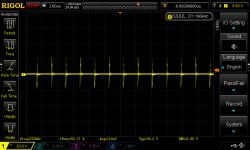
As with PAM8403, with PAM8610 the current consumption depends on the type of load (inductance).
If there is no input signal with disconnected speakers, the system uses 26mA,
connecting 8ohm speakers is 30mA consumption, connecting 8ohm resistors is 41mA, and with 4ohm resistors 44mA.
The differences in power consumption are much smaller than with the PAM8610.
The test system was powered with 15V, 8 ohm resistors were connected.
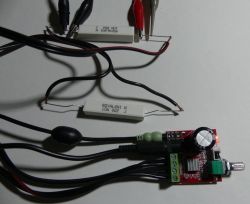
After giving the 1kHz signal, the familiar PAM8403 "chaff" appears on the output:

The output voltage of 2.8V at a resistance of 8 ohms corresponded to the output power of 2x1W,
current consumption at 15V was 0.423A, i.e. power consumption ~ 6.345W and efficiency ~ 32%.
2x5W power with an output voltage of 6.3V, required the delivery of 15V * 1.087A = 16.305W which gives the efficiency ~ 61% warm system.
Power 2x10W at a voltage of 8.9V on a resistor 8ohm, power consumption 15V * 1.731A = 25.965W which gives an efficiency of ~ 77%, the system is very warm.
The method of measurement is debatable, which was described in the previous material https://www.elektroda.pl/rtvforum/topic3458041.html
but the amplifier module is also unusual, the output signal is very different from a typical class D amplifier, eg TDA8932.
There are two jumpers on the board, one is closed (power on), the other is open (mute).
What do you think about the cheap PAM8610 amplifier module, where can it be used?
The material is a continuation of the previous one with a similar amplifier module based on PAM8403 : https://www.elektroda.pl/rtvforum/topic3458041.html
When testing the PAM8403, it turned out that the circuit at the output generates "chaff", while the current consumption is increased when we connect the 8om resistor at the output instead of the loudspeaker (with measurable inductance).
After connecting the module with the PAM8610, it turned out that without the presence of an input signal in the speakers it is present noise louder than in PAM8403 . The attempt to listen to the music was successful, the quality is acceptable.
The module was powered with 15V, 8 ohm resistors were connected to the outputs. In the absence of an input signal, the output is quite clear, causing the noise mentioned above:


As with PAM8403, with PAM8610 the current consumption depends on the type of load (inductance).
If there is no input signal with disconnected speakers, the system uses 26mA,
connecting 8ohm speakers is 30mA consumption, connecting 8ohm resistors is 41mA, and with 4ohm resistors 44mA.
The differences in power consumption are much smaller than with the PAM8610.
The test system was powered with 15V, 8 ohm resistors were connected.

After giving the 1kHz signal, the familiar PAM8403 "chaff" appears on the output:

The output voltage of 2.8V at a resistance of 8 ohms corresponded to the output power of 2x1W,
current consumption at 15V was 0.423A, i.e. power consumption ~ 6.345W and efficiency ~ 32%.
2x5W power with an output voltage of 6.3V, required the delivery of 15V * 1.087A = 16.305W which gives the efficiency ~ 61% warm system.
Power 2x10W at a voltage of 8.9V on a resistor 8ohm, power consumption 15V * 1.731A = 25.965W which gives an efficiency of ~ 77%, the system is very warm.
The method of measurement is debatable, which was described in the previous material https://www.elektroda.pl/rtvforum/topic3458041.html
but the amplifier module is also unusual, the output signal is very different from a typical class D amplifier, eg TDA8932.
There are two jumpers on the board, one is closed (power on), the other is open (mute).
What do you think about the cheap PAM8610 amplifier module, where can it be used?
Cool? Ranking DIY



